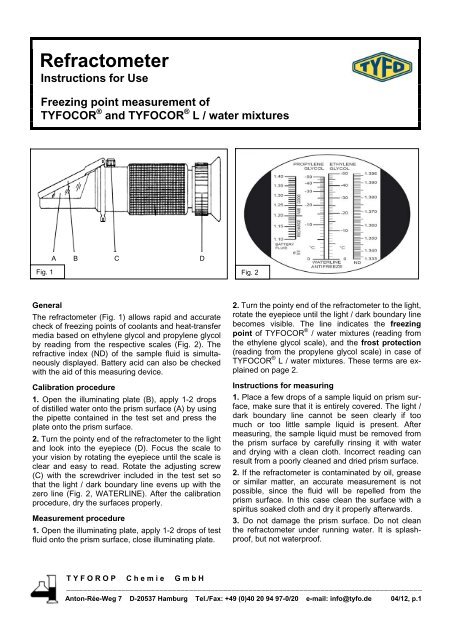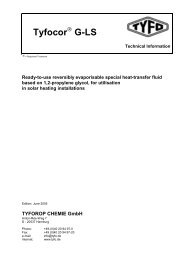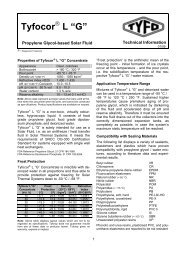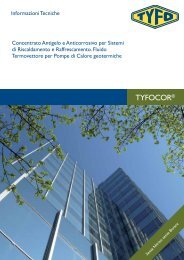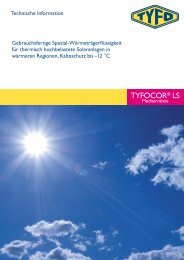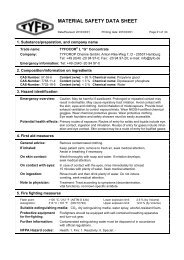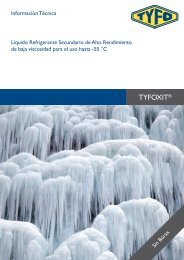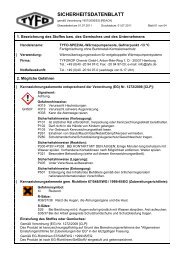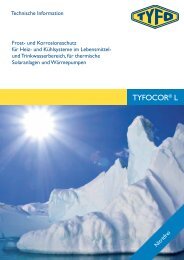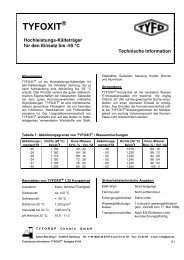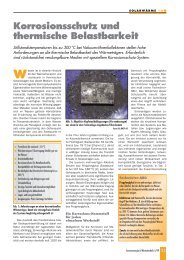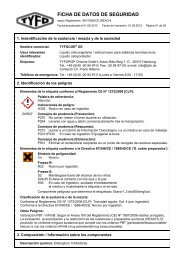Refractometer
Refractometer
Refractometer
You also want an ePaper? Increase the reach of your titles
YUMPU automatically turns print PDFs into web optimized ePapers that Google loves.
<strong>Refractometer</strong><br />
Instructions for Use<br />
Freezing point measurement of<br />
TYFOCOR ® and TYFOCOR ® L / water mixtures<br />
A B C D<br />
Fig. 1<br />
Fig. 2<br />
General<br />
The refractometer (Fig. 1) allows rapid and accurate<br />
check of freezing points of coolants and heat-transfer<br />
media based on ethylene glycol and propylene glycol<br />
by reading from the respective scales (Fig. 2). The<br />
refractive index (ND) of the sample fluid is simultaneously<br />
displayed. Battery acid can also be checked<br />
with the aid of this measuring device.<br />
Calibration procedure<br />
1. Open the illuminating plate (B), apply 1-2 drops<br />
of distilled water onto the prism surface (A) by using<br />
the pipette contained in the test set and press the<br />
plate onto the prism surface.<br />
2. Turn the pointy end of the refractometer to the light<br />
and look into the eyepiece (D). Focus the scale to<br />
your vision by rotating the eyepiece until the scale is<br />
clear and easy to read. Rotate the adjusting screw<br />
(C) with the screwdriver included in the test set so<br />
that the light / dark boundary line evens up with the<br />
zero line (Fig. 2, WATERLINE). After the calibration<br />
procedure, dry the surfaces properly.<br />
Measurement procedure<br />
1. Open the illuminating plate, apply 1-2 drops of test<br />
fluid onto the prism surface, close illuminating plate.<br />
2. Turn the pointy end of the refractometer to the light,<br />
rotate the eyepiece until the light / dark boundary line<br />
becomes visible. The line indicates the freezing<br />
point of TYFOCOR ® / water mixtures (reading from<br />
the ethylene glycol scale), and the frost protection<br />
(reading from the propylene glycol scale) in case of<br />
TYFOCOR ® L / water mixtures. These terms are explained<br />
on page 2.<br />
Instructions for measuring<br />
1. Place a few drops of a sample liquid on prism surface,<br />
make sure that it is entirely covered. The light /<br />
dark boundary line cannot be seen clearly if too<br />
much or too little sample liquid is present. After<br />
measuring, the sample liquid must be removed from<br />
the prism surface by carefully rinsing it with water<br />
and drying with a clean cloth. Incorrect reading can<br />
result from a poorly cleaned and dried prism surface.<br />
2. If the refractometer is contaminated by oil, grease<br />
or similar matter, an accurate measurement is not<br />
possible, since the fluid will be repelled from the<br />
prism surface. In this case clean the surface with a<br />
spiritus soaked cloth and dry it properly afterwards.<br />
3. Do not damage the prism surface. Do not clean<br />
the refractometer under running water. It is splashproof,<br />
but not waterproof.<br />
T Y F O R O P C h e m i e G m b H<br />
____________________________________________________________________________________<br />
Anton-Rée-Weg 7 D-20537 Hamburg Tel./Fax: +49 (0)40 20 94 97-0/20 e-mail: info@tyfo.de 04/12, p.1
<strong>Refractometer</strong><br />
Instructions for Use<br />
Freezing point measurement of<br />
TYFOCOR ® and TYFOCOR ® L / water mixtures<br />
Antifreeze effect of TYFOCOR ® and TYFOCOR ® L / water mixtures<br />
TYFOCOR ® (based on ethylene glycol) and TYFOCOR ® L (based on propylene glycol) lower the freezing<br />
point of water down to -50 °C, depending on their concentration.<br />
The freezing point, colloquially called “antifreeze”, is a measure for the freezing-point depression of<br />
antifreeze fluids. When a given TYFOCOR ® or TYFOCOR ® L / water mixture will be cooled down, the<br />
freezing point is the temperature at which initial ice crystals begin to form. The resulting ice slurry<br />
does not possess any expansive force. Further reduction in temperature causes further thickening of<br />
the ice slurry until it solidifies at the pour point. Only below this temperature, there is danger of<br />
bursting for the installation. The arithmetic mean from freezing point and pour point is referred to as<br />
frost protection.<br />
The following table displays the freezing points, frost protection and pour points of TYFOCOR ® and<br />
TYFOCOR ® L / water mixtures as a function of the concentration:<br />
TYFOCOR ® (reading from ethylene glycol scale)<br />
TYFOCOR ® L (reading from propylene glycol scale)<br />
% Freezing pt. Frost protection Pour point % Freezing pt. Frost protection Pour point<br />
vol. Reading<br />
vol.<br />
Reading<br />
20 - 9.0 °C - 11.0 °C - 13.0 °C 25 - 10.7 °C - 11.5 °C - 12.3 °C<br />
25 - 12.3 °C - 14.8 °C - 17.3 °C 30 - 14.0 °C - 15.0 °C - 16.0 °C<br />
30 - 16.1 °C - 19.1 °C - 22.0 °C 35 - 17.6 °C - 19.0 °C - 20.4 °C<br />
35 - 20.4 °C - 23.7 °C - 26.9 °C 40 - 21.5 °C - 23.7 °C - 26.0 °C<br />
40 - 25.2 °C - 28.6 °C - 32.0 °C 45 - 26.0 °C - 29.6 °C - 33.3 °C<br />
45 - 30.8 °C - 33.4 °C - 37.2 °C 50 - 32.4 °C - 38.2 °C - 44.0 °C<br />
50 - 37.6 °C - 40.7 °C - 45.2 °C 55 - 40.4 °C - 48.5 °C < -50 °C<br />
55 - 45.4 °C < - 50 °C < - 50 °C 60 - 48.4 °C < -50 °C < -50 °C<br />
In order to maintain effective protection from frost and corrosion, a concentration of at least 20<br />
volume percent of TYFOCOR ® Concentrate must be applied when mixed with water.<br />
In case of TYFOCOR ® L a minimum concentration of 25 volume percent must be applied. When<br />
used for Solar Thermal Systems, however, the concentration must be at least 40 volume percent.<br />
T Y F O R O P C h e m i e G m b H<br />
___________________________________________________________________________________<br />
Anton-Rée-Weg 7 D-20537 Hamburg Tel./Fax: +49 (0)40 20 94 97-0/20 e-mail: info@tyfo.de 04/12, p.2


